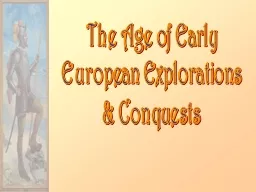

amp Conquests Earlier Explorations Islam amp the Spice Trade Malacca A New Player Europe Nicolo Maffeo amp Marco Polo 1271 Expansion becomes a state enterprise monarchs had the authority amp the resources ID: 697004
Download Presentation The PPT/PDF document "The Age of Early European Explorations" is the property of its rightful owner. Permission is granted to download and print the materials on this web site for personal, non-commercial use only, and to display it on your personal computer provided you do not modify the materials and that you retain all copyright notices contained in the materials. By downloading content from our website, you accept the terms of this agreement.
Slide1
The Age of Early
European Explorations
& ConquestsSlide2
Earlier Explorations
Islam & the Spice Trade
Malacca
A New Player
Europe
Nicolo, Maffeo, & Marco Polo, 1271
Expansion becomes a state enterprise
monarchs had the authority & the resources.
Better seaworthy ships.
Chinese Admiral Zheng He & the Ming “Treasure Fleet” Slide3
Admiral Zheng He
1371-1435
Each ship was 400’ long and 160’ wide!Slide4
A Map of the Known World,
pre- 1492Slide5
Motives for European Exploration
Crusades
by-pass intermediaries to get to Asia.
Renaissance
curiosity about other lands and peoples.
Reformation
refugees & missionaries.
Monarchs seeking new sources of revenue.
Technological advances.
Fame and fortune.Slide6
New Maritime Technologies
Hartman Astrolabe
(1532)
Better Maps [Portulan]
Sextant
Mariner’s CompassSlide7
New Weapons TechnologySlide8
Prince Henry, the Navigator
School for Navigation, 1419Slide9
Museum of Navigation
in LisbonSlide10
Portuguese Maritime Empire
Exploring the west coast of Africa.
Bartolomeo Dias, 1487.
Vasco da Gama, 1498.
Calicut.
Admiral Alfonso de Albuquerque (Goa, 1510; Malacca, 1511).Slide11
Zheng He’s Voyages
In 1498, Da Gama reached Calcutta, China’s favorite port!Slide12
Christofo Colon
[1451-1506]Slide13
Columbus’ Four VoyagesSlide14
Other Voyages of ExplorationSlide15
Ferdinand Magellan & the First Circumnavigation of the World:
Early 16
cSlide16
Atlantic Explorations
Looking for “El Dorado”Slide17
Fernando Cortez
The First Spanish Conquests:
The Aztecs
Montezuma II
vs.Slide18
The Death of Montezuma IISlide19
Mexico Surrenders to CortezSlide20
Francisco Pizarro
The First Spanish Conquests:
The Incas
Atahualpa
vs.Slide21
Slaves Working in a
Brazilian Sugar MillSlide22
Why would the
'Columbian Exchange'
be considered the
tsunami of
unintentional
"bio-terrorism"??Slide23
The “Columbian Exchange”
Squash
Avocado
Peppers
Sweet Potatoes
Turkey
Pumpkin
Tobacco
Quinine
Cocoa
Pineapple
Cassava
POTATO
Peanut
TOMATO
Vanilla
MAIZE
Syphilis
Olive
COFFEE BEAN
Banana
Rice
Onion
Turnip
Honeybee
Barley
Grape
Peach
SUGAR CANE
Oats
Citrus Fruits
Pear
Wheat
HORSE
Cattle
Sheep
Pigs
Smallpox
Flu
Typhus
Measles
Malaria
Diptheria
Whooping Cough
Trinkets
Liquor
GUNSSlide24
Cycle of Conquest & Colonization
Explorers
Conquistadores
Missionaries
Permanent
Settlers
Official
European
Colony!Slide25
Treasures
from the Americas!Slide26
Trans-Atlantic Slave TradeSlide27
The Slave Trade
Existed in Africa before the coming of the Europeans.
Portuguese replaced European slaves with Africans.
Sugar cane & sugar plantations.
First boatload of African slaves brought by the Spanish in 1518.
275,000 enslaved Africans exported
to other countries.
Between 16
c
& 19
c
, about 10 million Africans shipped to the Americas.Slide28
Slave Ship
“Middle Passage”Slide29
“Coffin” Position Below DeckSlide30
African Captives
Thrown Overboard
Sharks followed the slave ships!Slide31
European Empires in the AmericasSlide32
The Colonial Class System
Peninsulares
Creoles
Mestizos
Mulattos
Native Indians
Black SlavesSlide33
Administration of the Spanish Empire in the New World
Encomienda
or
forced
labor.
Council of
the Indies.
Viceroy.
New Spain and Peru.
Papal agreement.Slide34
The Influence of the Colonial Catholic Church
Guadalajara Cathedral
Our Lady of Guadalupe
Spanish MissionSlide35
The Treaty of Tordesillas, 1494 &
The Pope’s Line of DemarcationSlide36
Father Bartolome de Las Casas
New Laws
1542Slide37
New Colonial Rivals
Portugal lacked the numbers and wealth to dominate trade in the Indian Ocean.
Spain in Asia
consolidated its holdings in the Philippines.
First English expedition to the Indies in 1591.
Surat in NW India in 1608.
Dutch arrive in India in 1595.Slide38
New Colonial RivalsSlide39
Impact of European Expansion
Native populations ravaged by disease.
Influx of gold, and especially silver, into Europe created an inflationary economic climate.
[
“Price Revolution”
]
New products introduced across the continents [“Columbian Exchange”].
Deepened colonial rivalries.Slide40
5. New Patterns of World Trade